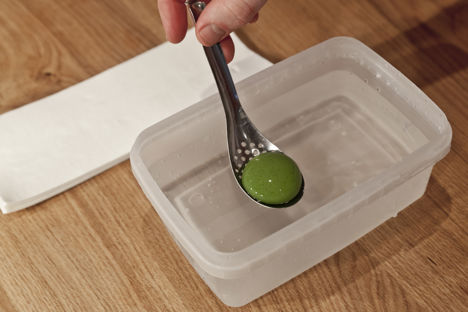Pioneered by Ferran Adrià (and his team of development chefs) at his famous El Bulli restaurant, spherification is a process which allows for the controlled jellification of a liquid – transforming it into a sphere with a thin gel membrane. While the exact science of this method – the reaction of sodium alginate (a thickening agent extracted from seaweed) coming into contact with calcium chloride – may be lost on most, it has become a widely used technique in modernist cuisine, seen through the prevalence of components such as olive oil 'caviar', spherified peas and mango ‘ravioli’.
Aside from providing a talking point at the table, the purpose of spherification is to achieve a textural sensation in the mouth – a spherified ingredient will hold its shape until bitten into, at which point it will release a burst of flavour. This could be puréed olive, pea or potato, or yoghurt, olive oil or even the liquid ingredients of your favourite cocktail.
There are now spherification kits available to buy online, so, providing you are aware of the fundamentals, there is no reason why you can’t add the technique to your armoury.
Basic spherification
Typically, spherification is achieved through evenly dispersing sodium alginate into a flavoured liquid (commonly, the ratio will be 0.5g of sodium alginate to every 100g of liquid) and plunging into a bath of cold water mixed with calcium chloride (also 0.5g to 100g of water). Upon being dropped into the solution, the liquid disperses and each droplet begins to encapsulate in a bubble. Once the spheres are formed, they can be transferred to another pool of fresh water to wash off the solution before being served. The whole process should take no longer than one hour.
Some of the issues with spherification as it was originally conceived are that it will not work with ingredients of a high acidity (the PH needs to be above 3.6, though this can be reduced using sodium citrate the resulting flavour may be quite sour) or calcium content, and that the ingredient will continue to jellify once it is out of the bath - meaning that unless it is served quickly it will turn into a solid ball of flavoured jelly rather than an essence protected by an imperceptibly thin membrane.
Reverse spherification
Reverse spherification – the process of adding a calcium-based or calcium-enriched product to a bath of sodium alginate – solves these issues, allowing the use of alcohol or milk and cream-based ingredients, for example, while also creating more durable, longer-lasting spheres. But reverse spherification has some downfalls of its own; notably that the liquid may need to be thickened with xanthan gum to allow it to penetrate the dense sodium alginate solution, and that the bath will take longer to prepare and requires the use of distilled water.
Equipment
Unlike many other modernist techniques, the equipment needed for spherification is actually quite rudimentary; a syringe or spoon for transferring the liquid, a container to hold the water solution, precisions scales and a blender (immersion if possible) are all that are strictly necessary. But if you are serious about spherification, it is probably wise to invest in some of the other gadgets available, such as a caviar maker (for evenly distributing the droplets of liquid into the water solution), vacuum chamber (to eliminate air bubbles created by mixing sodium alginate with a liquid), measuring spoons, moulds and PH indicator paper.
Get in touch
Please sign in or register to send a comment to Great British Chefs.



